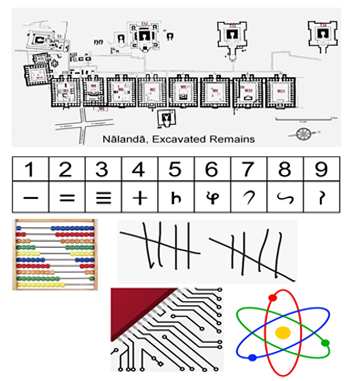University Logo: A Concept Note

The Logo of MGCUB is a combination of
(1) Charkha  and
and
(2) Abbreviation of the name of Mahatma Gandhi Central University, Bihar written as,  .
.
Concept note on Charkha 
The concept behind the Logo of Mahatma Gandhi Central University, Bihar (MGCUB) is derived from the Charkha, an iconic symbol representing Mahatma Gandhi. The Charkha is wrapping tricolor yarn spun by its dynamic activities symbolizing our national flag making it a University of national importance. Charka (form of wheel) is a symbolic representation for the progress and growth. The spinning wheel has been used metaphorically to signify transformation of raw material into a productive material that fabricates our society. This represents the national unity, dynamism and overall progress.
The color of Charkha is depicted in indigo blue connoting the first public movement against colonial rule by Mahatma Gandhi, the Champaran movement (Indigo Movement) one of the significant event of the region. The foundation year of the University marks centenary of this famous Champaran Movement. The design is an abstraction of the Charkha and the national movement.
In addition to the above concepts the design also represents the glowing/shinning sun/star in the middle. Sun is the source of energy connoting to the source of knowledge. Charkha is shown with eight spokes denoting spreading of knowledge and wisdom in all eight directions adding to the slogan of the University. In summary, the Logo features the concept of:
- Charkha (Symbolism of Gandhiji and wheel of life that generates yarn to weave our society besides national movement)
- Sun (the primary source of all life forms)
- Champaran Movement (specific event that illustrates the first Satyagraha of Gandhiji against the oppressive colonial regime and also signifies the local cultural context)
- Shining Star and white inward arrows in Charkha pointing towards the Centre (people coming together from every direction and converting into shining stars through quality education)
- Cardinal Directions (Spreading knowledge in all directions)
- Self Determination & Self-Reliance
Symbolism of eight spokes of Charkha wheel
Eight is a very important number in Indian tradition. It is believed that there is a group of eight deities, Asta Dikpala ![]() called literally meaning guardians of eight directions. Asthang Yog (Eightfold yoga) of Patanjali, Sashtang Namaskar (best salutation with whole body), Asht dhatu (considered sacred alloy), Asth prahar (eight divisions of day), ashtkoniya sthapatya (octagonal architecture) are other examples. In Hindu mythology, eight is the number of Adityas, Vasus and forms of Goddess Lakshmi.
called literally meaning guardians of eight directions. Asthang Yog (Eightfold yoga) of Patanjali, Sashtang Namaskar (best salutation with whole body), Asht dhatu (considered sacred alloy), Asth prahar (eight divisions of day), ashtkoniya sthapatya (octagonal architecture) are other examples. In Hindu mythology, eight is the number of Adityas, Vasus and forms of Goddess Lakshmi.
The Dharmacakra, a Buddhist symbol, has eight spokes. Buddha's principal teaching - the Four Noble Truths - ramifies as the Noble Eightfold Path and Buddha has emphasized upon the importance of the eight attainments.
Eight also finds a prominent place in Islam, Christianity, Judaism, Sikhism and Jainism.
In Islam, eight is the number of angels carrying the throne of Allah in heaven, and the number of gates of bahisht (heaven).


In Christian religion, Peter 3:20 states that there were eight people on Noah's Ark.
"Which sometime were disobedient, when once the longsuffering of God waited in the days of Noah, while the ark was a preparing, wherein few, that is, eight souls were saved by water." (Bible, King James Version, 1. Peter: 20)
The Beatitudes are 8 blessings recounted in the Sermon on the Mount in the Gospel of Matthew. (Matthew 5:1-12)
Sukhmani Sahib is part of Shri Granth Sahib and was compiled by the fifth Sikh Guru, Guru Shri Arjan Dev Ji. It has exactly 192 hymns with 24 (divisible by 8) sections. Group of 8 hymns are known as Ashtpadi in Sikhism. Ashtpadi, literally 8 steps is a music composition with 8 lines. It is considered rhyme of love and supreme devotion.
In Jainism, the number of Tirthankars is 24 (a multiple of 8) and Jain Karma theory classifies karmas into 8 types. (Jaini, Padmanabh S. , The Jaina Path of Purification, Delhi: Motilal Banarsidass, 1998)
Concept note on 

-
Theme/Philosophy
The First Alphabets of 'Mahatma Gandhi Central University, Bihar'-'MGCUB' taken as basics for the Logo. - Following Educational/Cultural Elements represented in creating the MGCUB Logo
- The Building Foundation � Design of ancient Nalanda University in Bihar
- Brahmi Numerals (1st Century, India)
- Tally Marks/Hash Marks, Amongst others, Squares + Dots commonly used in forestry for counting
- Abacus
- Scientific symbols including computer chip
- Educational: Panth Nirpeksh, Inclusive
The basic Alphabets of the Logo, representing educational facility (like the Nalanda University) also shows �Openness� for all imparting & seeking knowledge. Each Alphabet of the Logo has open space for Entrance and Lines and Dots connecting Students and Gurus. All are welcome to come-in, teach, learn and also go out and spread the knowledge learnt at MGCUB. -
Colours for the Logo
- Blue- for Flow of knowledge, bringing prosperity to all along the way, like a river
- Green- for growth through the knowledge like the green fields and trees
- Saffron- representing Gurus and Shishyas


